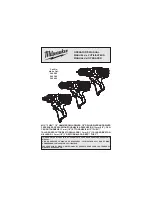
10
Noise
ENG905-1
The typical A-weighted noise level determined according
to EN62841-2-11:
Model DJR143, DJR185
Sound pressure level (L
pA
): 76 dB (A)
Uncertainty (K): 3 dB (A)
The noise level under working may exceed 80 dB (A).
Model DJR183
Sound pressure level (L
pA
): 77 dB (A)
Uncertainty (K): 3 dB (A)
The noise level under working may exceed 80 dB (A).
ENG907-1
• The declared noise emission value(s) has been
measured in accordance with a standard test method
and may be used for comparing one tool with another.
• The declared noise emission value(s) may also be
used in a preliminary assessment of exposure.
WARNING:
• Wear ear protection.
• The noise emission during actual use of the power
tool can differ from the declared value(s)
depending on the ways in which the tool is used
especially what kind of workpiece is processed.
• Be sure to identify safety measures to protect the
operator that are based on an estimation of
exposure in the actual conditions of use (taking
account of all parts of the operating cycle such as
the times when the tool is switched off and when it
is running idle in addition to the trigger time).
Vibration
ENG900-1
The vibration total value (tri-axial vector sum) determined
according to EN62841-2-11:
Model DJR143
Work mode: cutting boards
Vibration emission (a
h, B
): 7.0 m/s
2
Uncertainty (K): 1.5 m/s
2
Work mode: cutting wooden beams
Vibration emission (a
h, WB
): 7.0 m/s
2
Uncertainty (K): 1.5 m/s
2
Model DJR183, DJR185
Work mode: cutting boards
Vibration emission (a
h, B
): 8.0 m/s
2
Uncertainty (K): 1.5 m/s
2
Work mode: cutting wooden beams
Vibration emission (a
h, WB
): 7.0 m/s
2
Uncertainty (K): 1.5 m/s
2
ENG901-2
• The declared vibration total value(s) has been
measured in accordance with a standard test method
and may be used for comparing one tool with another.
• The declared vibration total value(s) may also be used
in a preliminary assessment of exposure.
WARNING:
• The vibration emission during actual use of the
power tool can differ from the declared value(s)
depending on the ways in which the tool is used
especially what kind of workpiece is processed.
• Be sure to identify safety measures to protect the
operator that are based on an estimation of
exposure in the actual conditions of use (taking
account of all parts of the operating cycle such as
the times when the tool is switched off and when it
is running idle in addition to the trigger time).
EC Declaration of Conformity
For European countries only
The EC declaration of conformity is included as Annex A
to this instruction manual.











































